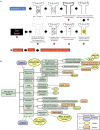Pharmacological Approach for Neuroprotection After Cardiac Arrest-A Narrative Review of Current Therapies and Future Neuroprotective Cocktail
- PMID: 34084772
- PMCID: PMC8167895
- DOI: 10.3389/fmed.2021.636651
Pharmacological Approach for Neuroprotection After Cardiac Arrest-A Narrative Review of Current Therapies and Future Neuroprotective Cocktail
Abstract
Cardiac arrest (CA) results in global ischemia-reperfusion injury damaging tissues in the whole body. The landscape of therapeutic interventions in resuscitation medicine has evolved from focusing solely on achieving return of circulation to now exploring options to mitigate brain injury and preserve brain function after CA. CA pathology includes mitochondrial damage and endoplasmic reticulum stress response, increased generation of reactive oxygen species, neuroinflammation, and neuronal excitotoxic death. Current non-pharmacologic therapies, such as therapeutic hypothermia and extracorporeal cardiopulmonary resuscitation, have shown benefits in protecting against ischemic brain injury and improving neurological outcomes post-CA, yet their application is difficult to institute ubiquitously. The current preclinical pharmacopeia to address CA and the resulting brain injury utilizes drugs that often target singular pathways and have been difficult to translate from the bench to the clinic. Furthermore, the limited combination therapies that have been attempted have shown mixed effects in conferring neuroprotection and improving survival post-CA. The global scale of CA damage and its resultant brain injury necessitates the future of CA interventions to simultaneously target multiple pathways and alleviate the hemodynamic, mitochondrial, metabolic, oxidative, and inflammatory processes in the brain. This narrative review seeks to highlight the current field of post-CA neuroprotective pharmaceutical therapies, both singular and combination, and discuss the use of an extensive multi-drug cocktail therapy as a novel approach to treat CA-mediated dysregulation of multiple pathways, enhancing survival, and neuroprotection.
Keywords: cardiopulmonary arrest; cerebral ischemia; cocktail therapy; ischemia and reperfusion injury; neuroprotection; pharmacological intervention; resuscitation.
Copyright © 2021 Choudhary, Shoaib, Sohnen, Rolston, Jafari, Miyara, Hayashida, Molmenti, Kim and Becker.
Conflict of interest statement
LB has a grant/research support from Philips Healthcare, the NIH, Nihon Kohden Corp., Zoll Medical Corp, PCORI, BrainCool, and United Therapeutics and owns several issued and pending patents involving the use of medical slurries as human coolant, devices to create slurries, reperfusion cocktails, and measurement of respiratory quotient. The remaining authors declare that the research was conducted in the absence of any commercial or financial relationships that could be construed as a potential conflict of interest.
Figures

Similar articles
-
Multi-Drug Cocktail Therapy Improves Survival and Neurological Function after Asphyxial Cardiac Arrest in Rodents.Cells. 2023 Jun 5;12(11):1548. doi: 10.3390/cells12111548. Cells. 2023. PMID: 37296668 Free PMC article.
-
A systematic review of neuroprotective strategies after cardiac arrest: from bench to bedside (Part I - Protection via specific pathways).Med Gas Res. 2014 May 1;4:9. doi: 10.1186/2045-9912-4-9. eCollection 2014. Med Gas Res. 2014. PMID: 24808942 Free PMC article. Review.
-
Inhaled Gases as Therapies for Post-Cardiac Arrest Syndrome: A Narrative Review of Recent Developments.Front Med (Lausanne). 2021 Jan 14;7:586229. doi: 10.3389/fmed.2020.586229. eCollection 2020. Front Med (Lausanne). 2021. PMID: 33585501 Free PMC article. Review.
-
Neuroprotective Approaches for Brain Injury After Cardiac Arrest: Current Trends and Prospective Avenues.J Stroke. 2024 May;26(2):203-230. doi: 10.5853/jos.2023.04329. Epub 2024 May 30. J Stroke. 2024. PMID: 38836269 Free PMC article. Review.
-
Pharmacologic neuroprotection in ischemic brain injury after cardiac arrest.Ann N Y Acad Sci. 2022 Jan;1507(1):49-59. doi: 10.1111/nyas.14613. Epub 2021 May 31. Ann N Y Acad Sci. 2022. PMID: 34060087 Review.
Cited by
-
Sesamol defends neuronal damage following cerebral ischemia/reperfusion: a crosstalk of autophagy and Notch1/NLRP3 inflammasome signaling.Inflammopharmacology. 2024 Feb;32(1):629-642. doi: 10.1007/s10787-023-01355-1. Epub 2023 Oct 17. Inflammopharmacology. 2024. PMID: 37848698 Free PMC article.
-
Threshold adjusted vagus nerve stimulation after asphyxial cardiac arrest results in neuroprotection and improved survival.Bioelectron Med. 2022 Jul 20;8(1):10. doi: 10.1186/s42234-022-00092-0. Bioelectron Med. 2022. PMID: 35854394 Free PMC article.
-
Multi-Drug Cocktail Therapy Improves Survival and Neurological Function after Asphyxial Cardiac Arrest in Rodents.Cells. 2023 Jun 5;12(11):1548. doi: 10.3390/cells12111548. Cells. 2023. PMID: 37296668 Free PMC article.
-
Association between ASL MRI-derived cerebral blood flow and outcomes after pediatric cardiac arrest.Resuscitation. 2024 Mar;196:110128. doi: 10.1016/j.resuscitation.2024.110128. Epub 2024 Jan 26. Resuscitation. 2024. PMID: 38280508 Free PMC article.
-
Vagus Nerve Stimulation Improves Mitochondrial Dysfunction in Post-cardiac Arrest Syndrome in the Asphyxial Cardiac Arrest Model in Rats.Front Neurosci. 2022 May 26;16:762007. doi: 10.3389/fnins.2022.762007. eCollection 2022. Front Neurosci. 2022. PMID: 35692415 Free PMC article.
References
-
- Geocadin RG, Callaway CW, Fink EL, Golan E, Greer DM, Ko NU, et al. . Standards for studies of neurological prognostication in comatose survivors of cardiac arrest: a scientific statement from the American Heart Association. Circulation. (2019) 140:e517–42. 10.1161/CIR.0000000000000702 - DOI - PubMed
Publication types
LinkOut - more resources
Full Text Sources
Other Literature Sources

